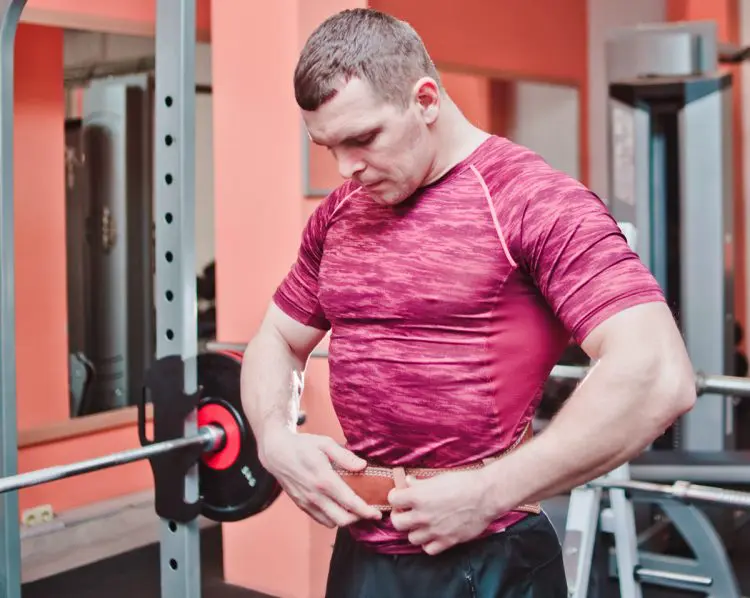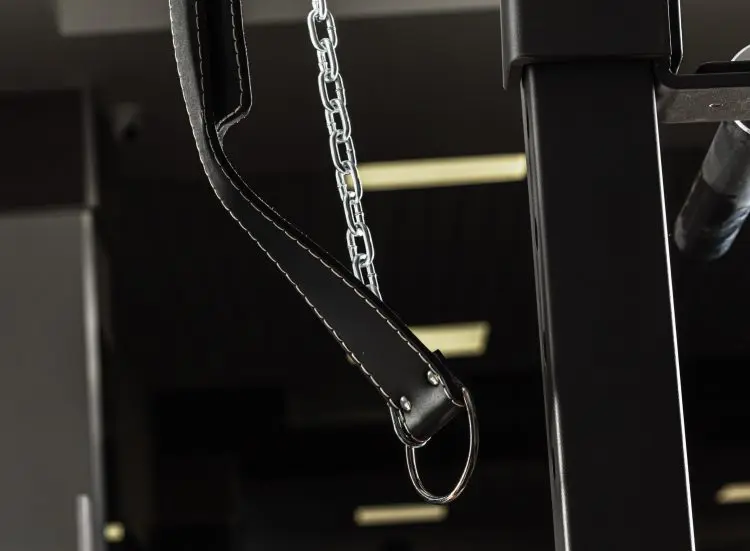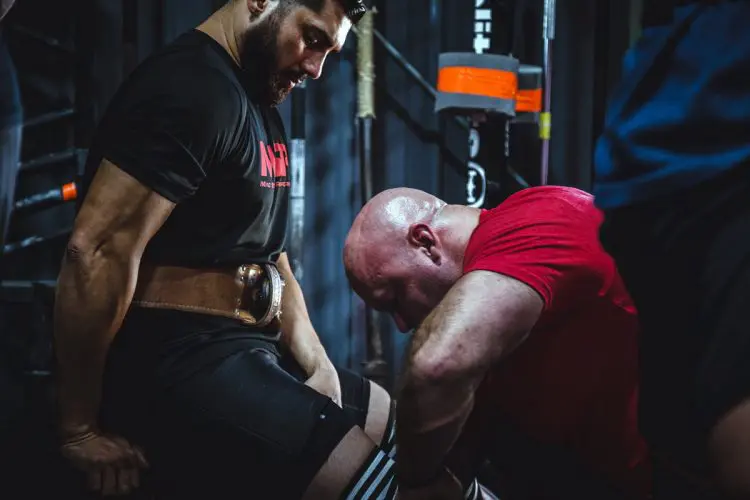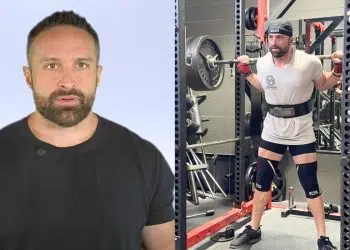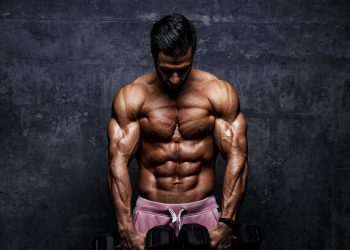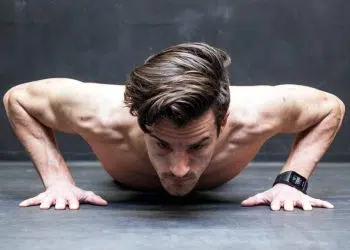When it comes to improving your strength, it’s important that you are regularly lifting heavy. There are a number of training tools that you may want to consider that may assist you with your heavy lifts.
You may have noticed that many of the top powerlifters, weightlifters, and strength athletes in the world often wear weight belts when training. Why is this? What are the benefits? And should you be using a weight belt in your training?
This article will consider the pros and cons of the lifting belt and help you understand whether it is a training tool you should be using in your own training.
What Are Lifting Belts?
Lifting belts are leather straps that wrap around the lower torso and help to generate additional pressure in the abdomen.
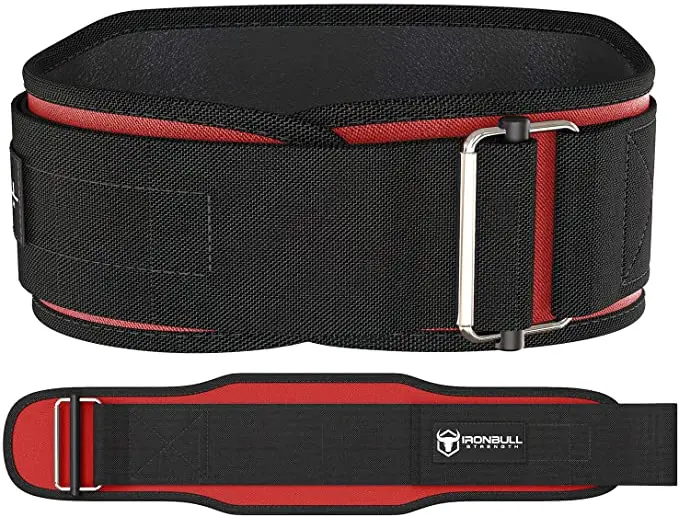
There are three common types of lifting belt – the double-pronged, single-pronged, and lever belt. These terms simply refer to the attachment method that the belt uses.
Level Up Your Fitness: Join our 💪 strong community in Fitness Volt Newsletter. Get daily inspiration, expert-backed workouts, nutrition tips, the latest in strength sports, and the support you need to reach your goals. Subscribe for free!
Belts also come in a variety of thicknesses. While most belts range between 10 – 13mm, you can also get thinner 6mm belts.
The shape and design of each belt may also vary from manufacturer to manufacturer. Some belts have a wide back and tapered front while others are made from a single, solid piece of leather.
The type of belt that you use is entirely dependent on your own preferences and budget.
Check out the best quality weightlifting and bodybuilding belts reviewed.
Wearing A Lifting Belt
As mentioned, lifting belts should pass around the lower abdomen. More specifically, it should sit right above the hip bones.
You must ensure that it is positioned correctly as placing it too high or too low is going to cause some real discomfort.
When wearing a lifting belt, you must ensure that it is tight but not excessively so. By tightening the belt too much, you may find it difficult to breathe properly.
That said, it’s a fine line because if the belt is not tight enough, you will not have anything to brace against which will render the belt useless.
If you’re new to lifting with a belt, it may take some trial and error for you to determine the correct amount of tightness.
Why Are Lifting Belts Used?
Regardless of thickness and design, the purpose of each lifting belt is the same – to improve strength performance and reduce injury risk.
So, how does a simple piece of leather actually do this?
Firstly, there is nothing magical about the weight lifting belt. Contrary to belief the weight belt does not directly support the lower back.
Instead, the lifting belt provides the body with something known as external feedback which causes the core muscles to activate to a greater degree.
In simpler terms, the belt provides the core muscles with something to brace against which allows for a stronger and more consistent contraction.
Additionally, providing the belt is worn appropriately and bracing done correctly, intra-abdominal pressure will also substantially increase.
This increase in pressure supports the spine and reduces the amount of compressive force placed on the spinal discs.
Therefore, it is a combination of greater muscle activation and an increase in intra-abdominal pressure that is responsible for improving strength performance and for protecting the spine.
Understanding Intra-Abdominal Pressure
This section will expand a little on intra-abdominal pressure (IAP), why it is important during lifting, and the impact of lifting belts on this pressure.
As you may be able to work out from the word, intra-abdominal pressure refers to the force generated within the abdominal cavity.
If you’re a seasoned lifter, it’s likely that you already increase your IAP before performing a lift, possibly without even recognizing it.
To do this, you will likely do two things before lifting. First, you will take a deep breath and hold it during the eternity of the rep and, secondly, you will actively squeeze your core muscles.
Diaphragmatic breathing has been consistently found to increase IAP. This involves breathing deeply into the belly rather than performing shallow chest breaths.
Holding your breath (also known as the Valsalva maneuver) has also been found to enhance IAP and contribute towards spinal support and stability (1).
Finally, there is a range of muscles in the torso that influence intra-abdominal pressure; these include the abdominals, obliques, diaphragm, multifidus, and pelvic floor muscles.
A combination of diaphragmatic breathing, the Valsalva maneuver, and powerful activation of all of the core muscles will lead to a significant increase in pressure.
So, what exactly are the benefits of increasing IAP?
As touched upon, increasing IAP provides the spine with support and stability. This is particularly important when performing “big” exercises such as the squat, deadlift, bench, and overhead press.
Engaging the core and practicing breath control will enhance IAP and increase upper body stiffness. This will consequently keep the trunk in the correct position and prevent the spine from rounding.
Generating as much pressure as possible is crucial if you want to lift heavy loads safely and with good form. Failure to increase IAP may inhibit performance as well as elevate your injury risk.
Finally, there is some evidence to suggest that increasing IAP can also improve hip extension strength (2) thus improving your performance with particular exercises.
Lifting Belts and Intra-Abdominal Pressure
As reflected on, lifting belts act as an external stimulus to facilitate the contraction of many core muscles thus increasing IAP.
Studies on weight lifting belts have concluded that they do effectively enhance IAP.
Level Up Your Fitness: Join our 💪 strong community in Fitness Volt Newsletter. Get daily inspiration, expert-backed workouts, nutrition tips, the latest in strength sports, and the support you need to reach your goals. Subscribe for free!
As a result, lifting belts may reduce compressive forces on the spine and generally promote lifting safely (3).
Therefore, it may be worthwhile to use a lifting belt, particularly with heavy lifting where technique can become compromised more easily and the risk of injury tends to be higher.
Finally, because increasing IAP appears to improve hip extension strength, weight belts may also facilitate an improved performance with exercises that involve hip extension, such as the squat and deadlift.
Which Exercises Should You Use A Belt?
Lifting belts are commonly used with your heaviest lifts such as:
Many of these exercises place a huge demand on core strength and stability which helps to explain why belts are often used when performing them.
However, belts can really be used with any exercise that you desire. If you are finding it challenging to remain stable or maintain core engagement during an exercise, consider using a belt.
Lifting Belt Concerns
While belts do appear to have their benefits, there have been questions raised regarding their safety.
While increasing IAP does have it’s benefits, it can also increase blood pressure (4).
Therefore, some sports scientists are concerned that regular use of weight belts can increase your risk of developing hernias, varicose veins, and hemorrhoids.
However, it should be noted that the increase in blood pressure associated with lifting belts is temporary and intermittent, therefore, it may not be a huge cause for concern.
If you were to wear a weight lifting belt all day and elevate your blood pressure for a significant amount of time, then there would be a higher chance of developing these issues.
Ultimately there is simply not enough research on the matter to make a definitive conclusion. More needs to be done to confirm whether weight belts can increase the risk of hernias, varicose veins, and hemorrhoids.
That said, for those who suffer from high blood pressure or cardiovascular-related diseases, elevating IAP may not be recommended as this may only serve to increase their blood pressure further.
These individuals should always consult a qualified medical and fitness professional before using training aids like a weight belt.
Finally, it has been suggested that weight belts can actually negatively impact core strength in the long run.
The hypothesis is that weight belts take the demand off the lower back, abs, and obliques thus preventing them from becoming strong and increasing the risk of injury.
There is no evidence to suggest that this is the case.
In fact, one study comparing lifting with and without weight belts concluded that lifting with a compression belt worked the lower back and core muscles equally as hard (5).
Are Lifting Belts Right For You?
It’s clear that weight lifting belts can have a positive impact on strength performance, however, this does not mean that everyone should use them.
Ultimately, whether or not you use a belt is dependent on your fitness goal.
If your goal is to generally improve your health and fitness, weight belts are not really necessary. You can experience all of the benefits of strength training without having to utilize a weight belt.
However, if you are a lifter who is looking to significantly improve their strength, then it would make sense to use a lifting belt.
Athletes who regularly lift a significant amount of weight will also benefit from using a weight belt.
That said, weight belts should not be considered compulsory for these populations. You can still achieve your strength goals without having to use a belt.
Some lifters love using the belt and feel a lot more comfortable doing so while others find it to be unnecessary and prefer to exercise without it.
There is no right or wrong here. Ultimately, weight lifting belts are optional tools that you may or may not wish to use.
Technique Considerations
It’s very important that you don’t use the weight belt in an attempt to improve your technique. While the belt may increase IAP, it will not rectify poor form.
Using a weight lifting belt is not an excuse to lift with poor technique or to lift excessively heavy weight. The weight belt will not protect you from injury.
Always lift within your limits, especially if you’re a beginner or intermediate lifter, and practice good technique with each and every exercise.
Final Word
The research conducted on weight lifting belts suggests that they can be an effective training tool. They appear to elevate intra-abdominal pressure thus enhancing strength and stability.
Therefore, by using a weight belt it may be possible to lift heavier and substantially increase your strength. That said, weight belts should not be considered compulsory as they may not be appropriate for every lifter.
References:
1- Hackett, Daniel A.; Chow, Chin-Moi (2013-08). “The Valsalva maneuver: its effect on intra-abdominal pressure and safety issues during resistance exercise”. Journal of Strength and Conditioning Research. 27 (8): 2338–2345. doi:10.1519/JSC.0b013e31827de07d. ISSN 1533-4287. PMID 23222073. [source]
2- Tayashiki, Kota; Mizuno, Fumihiro; Kanehisa, Hiroaki; Miyamoto, Naokazu (2018-01). “Causal effect of intra-abdominal pressure on maximal voluntary isometric hip extension torque”. European Journal of Applied Physiology. 118 (1): 93–99. doi:10.1007/s00421-017-3748-0. ISSN 1439-6327. PMID 29085998. [source]
3- Harman, E. A.; Rosenstein, R. M.; Frykman, P. N.; Nigro, G. A. (1989-04). “Effects of a belt on intra-abdominal pressure during weight lifting”. Medicine and Science in Sports and Exercise. 21 (2): 186–190. ISSN 0195-9131. PMID 2709981. [source]
4- Hunt, Leanne; Frost, Steve A; Hillman, Ken; Newton, Phillip J; Davidson, Patricia M (2014-02-05). “Management of intra-abdominal hypertension and abdominal compartment syndrome: a review”. Journal of Trauma Management & Outcomes. 8: 2. doi:10.1186/1752-2897-8-2. ISSN 1752-2897. PMC 3925290. PMID 24499574. [source]
5- McGill, S. M.; Norman, R. W.; Sharratt, M. T. (1990-02). “The effect of an abdominal belt on trunk muscle activity and intra-abdominal pressure during squat lifts”. Ergonomics. 33 (2): 147–160. doi:10.1080/00140139008927106. ISSN 0014-0139. PMID 2141312. [source]

